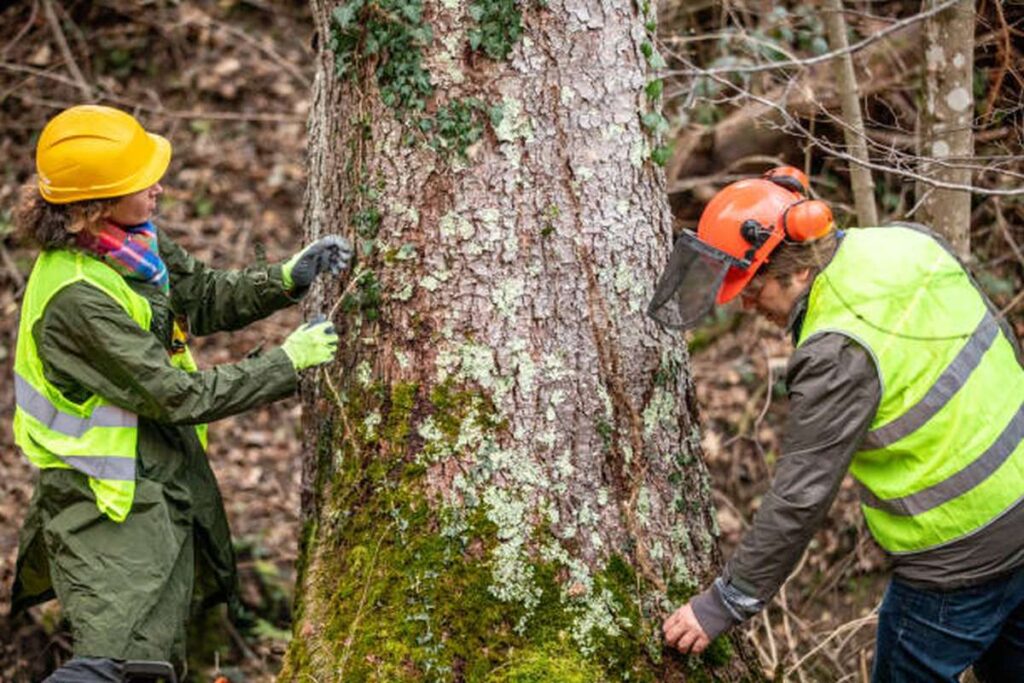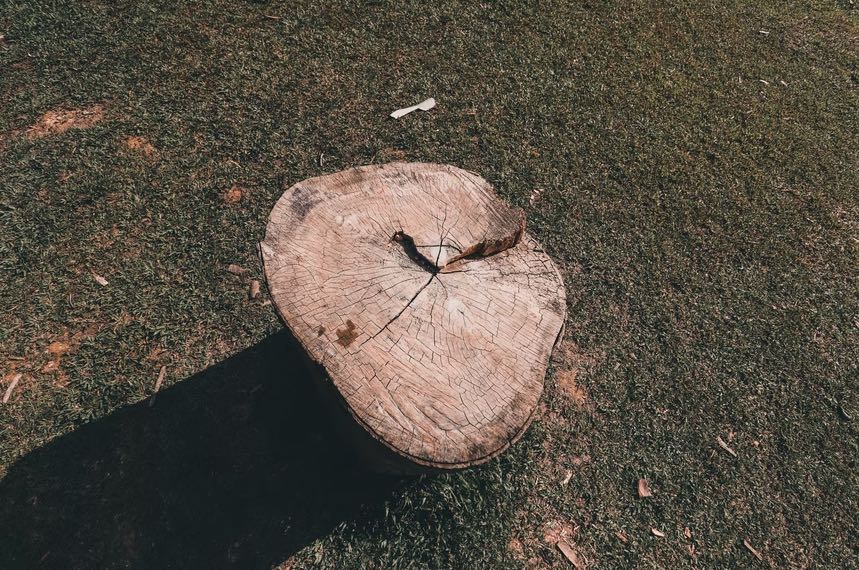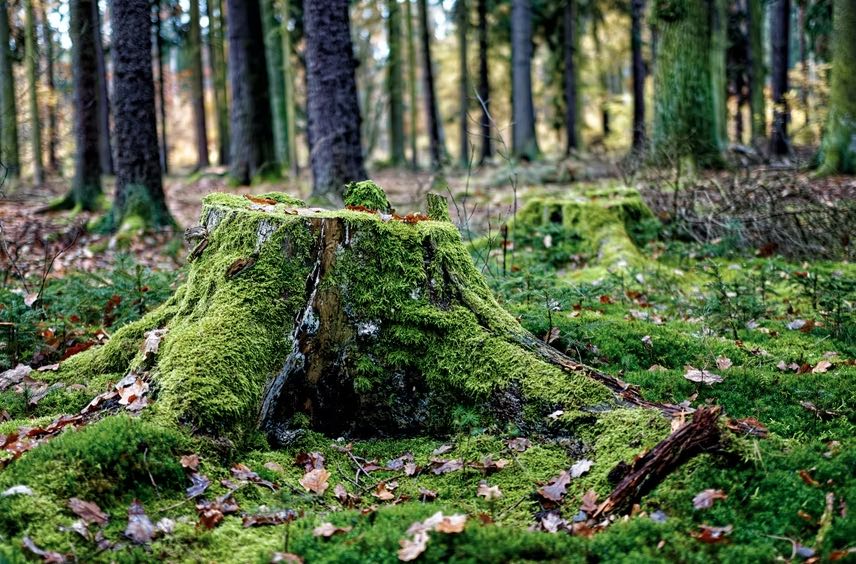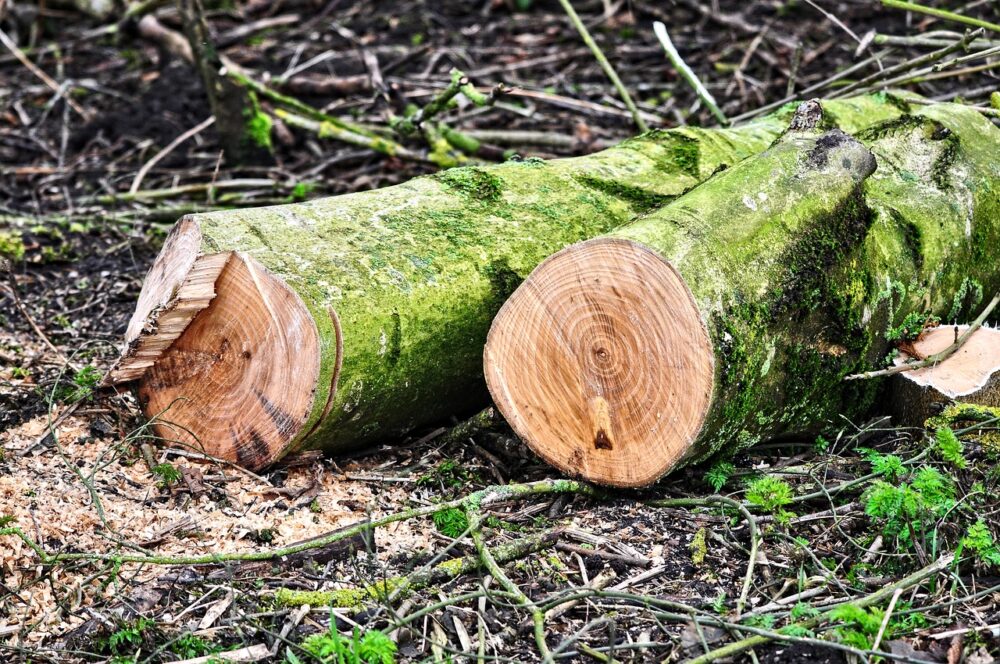Tree removal is relatively easy in comparison to stump grinding, despite first impressions to the contrary. Stump removal is typically not included in the price of tree removal because of the additional work involved. For the same reason, many homeowners will keep a lone stump in their garden. Taking out a stump isn't a walk in the park, but it is possible. Using the appropriate strategies and procedures will allow you to do the task more swiftly and easily.
Stump removal is a job best left to the pros, whether you inherited a stump from a downed tree when you bought your house or you plan to cut down a tree in your yard and need to have its base removed because its roots are causing structural damage, you want to make room for an addition, or you simply want to let in more light.
Many customers yearn for a perfectly smooth lawn, but yards marred by unsightly stumps can detract from the overall look.
Stump removal is a more involved process than tree removal. Among other things, this is why expert tree service doesn't provide it. Depending on the approach taken, this might be a time-consuming operation that requires a variety of specialised equipment. It is possible to remove a stump using a variety of techniques, some of which are simple enough for the do-it-yourselfer to tackle.
Here are some of the most common blunders people make when removing a stump, along with some expert-recommended solutions.
Why Should I Remove A Stump?
Assuming the homeowner is content with the status quo, the stump may be left alone. Maybe they'll incorporate it into their outside design. But there are occasions when you need to cut down a stump. And here's why:
- Hazards. When vegetation such as grass, moss, or other plants begins to grow on top of a stump, it might constitute a tripping hazard. Lawnmowers and other garden machinery are also susceptible to harm.
- Attractive. However, the stump is only attractive to weeds and insects, and even less so if it has begun to rot.
- Eyesores. When you've had more than one tree cut down, there will be more than one stump left for you to stare at and avoid.
You should evaluate the stump's ease of removal before attempting to remove it. Having a strategy in place can make almost any task easier. Knowing the species of tree you're dealing with and the potential depth of its roots will help narrow down your options. Dimensions, age, and the quantity of stumps should all be taken into account. Take a look at your stump and decide which type of removal will work best for you.
It would be inefficient to remove a tree but then just leave the stump in the ground. Stump removal is highly recommended for a number of reasons, including:
- This is an eyesore. Nobody enjoys looking out at a yard full of unsightly old stumps. Once weeds and other plants begin to grow on them, they take on an even more unsightly appearance.
- They're a waste of precious real estate. People often want yards that are as open and spacious as possible, and stumps present a major obstruction.
- Threatening in nature. Some stumps are easy to spot, while others might become hidden by vegetation and cause accidents. A painful stubbed toe is the only upside to stumbling across a tree stump.
Assessing A Tree Stump
Different methods can be used for the removal of different types of stumps. In the long run, you'll have a much easier time if you take the time to plan ahead and learn which strategies and procedures are best suited for each type of project. Pine tree stumps, for instance, are typically simpler to remove than those of deciduous trees. This is because pine trees have wide, flat, and shallow roots while deciduous trees have long, deep roots, making pine tree stumps easier to remove.
Which factors facilitate stump grinding? The difficulty of removing a stump is typically proportional to the tree's age and size. The simpler the stump, the easier it is to remove it. The same holds true for stumps: smaller ones are less of a hassle to get rid of than bigger ones. Think about how many stumps need to be removed before deciding on a procedure. For instance, is it your intention to manually remove 100 stumps? To the extent that number exceeds 3? You can use the information in this manual to figure out what methods and strategies for removing the stump work best for you.
Methods For Removing Tree Stumps
Removing a stump is necessary to eliminate hazards, enhance the aesthetic value of your property, and stop pests from establishing a breeding ground. Professional assistance is recommended when removing a tree or a tree stump. Stump removal can protect the safety of anyone working on the property, but the cost can vary widely depending on things including the method employed and the amount of stumps to be removed. There are five common techniques used nowadays for removing stumps.
Stump removal is necessary for many different reasons. Stump removal is necessary if they are interfering with other parts of your landscaping. An old tree stump isn't very useful, and it certainly isn't anything to be proud of. However, its intertwining root system still poses a threat to underground pipes. This may make it impossible to tend to your yard. The difficulty of working around tree roots is something that can only be experienced firsthand.
Stump Grinding
If you're a homeowner seeking for a quick and easy method to get rid of a stump, grinding is your best bet. When using a stump grinder, you can get up to 18 inches deep into the earth to get to the trunk and roots. The wood can then be used as compost when the stump has been removed. Although a grinder can be rented from a hardware store, it is recommended that you hire a professional. They understand how to safely operate the machinery and can anticipate any problems.
Burning the Stump
After cutting down a tree, many people decide to burn the remnants. Keep in mind that this strategy has a lower environmental score.
Hand-Removal Of A Stump
Tree stumps can be removed manually by homeowners with the use of a chainsaw, shovel, and axe. If you have a little or old, sick tree on your property, you can use this procedure to get rid of the stump. The first step is to dig around the bottom to get to the roots. Then, chop the roots with an axe until the entire trunk is uprooted.
Tree Stump Rot
Natural stump elimination via decaying is analogous to the more common burning procedure. Making holes in the stump and filling it with a high-nitrogen component that aids in breakdown comes first. Next, water is poured into the holes and the stump is chipped away as it rots. After the tree has been cut down to the ground and the stump has been removed, the hole should be backfilled with dirt. This method of stump removal may take more time than some others.
Chemical Method
It is important to learn about the potential risks to the environment and any regulations that may apply before choosing a chemical for tree and stump removal. This task may be best left to experts who have the resources and training to collect and handle the necessary chemicals properly.
DON'Ts For Tree Stump Removal
- Avoid cutting down a tree and leaving behind nothing but a stump. We discussing tree felling in a piece dedicated to stump grinding because, in most cases, grinding out the stump should be done simultaneously with cutting down the tree. What you don't want is for the rotting wood from the stump to attract insects and fungi, which could spread to your other healthy trees. Suckers could sprout from the stump, giving it new life but also competing with your other plants for soil moisture and nutrients.
- The stump should not be burned. If you've inherited an old tree stump and it isn't rotting or producing suckers, you can burn it; however, this will create a mess. A chemical accelerant could be required to get the fire going, and even for a relatively tiny stump, it could take a full day to burn everything away. However, if the tree stump has an excessive amount of moisture, you shouldn't try to burn it, as you won't be able to get very far even with the help of a chemical accelerant.
- Sap is rising throughout the spring and early summer, making those times inappropriate for applying stump killer. By preventing the stump from regenerating, stump killer hastens the decaying process. Because it will take many years for the stump to really decay away, it is likely that it will outlive your ownership of the property if you choose this long-term solution.
DOs For Tree Stump Removal
There are three standard methods for removing tree stumps: digging and pulling, chemical treatments, and grinding.
- Stump grinding This is the procedure we mostly use for getting rid of stumps, whether they are fresh from being cut down or have been there for a long time and are now completely dead. It's efficient, quick, and allows you to get right back to work on your garden redesign. DO give safety some thought, especially when trying to move the always heavy grinding devices into place (through a home, down the side of a property, or through a neighbor's garden when there is no other way in) and when using it; at the very least, sturdy boots, you should wear gloves, eye protection, and long, strong trousers. If you want to kill the roots and prevent sucker growth, you should cut them down to the ground at least 10 centimetres before covering them with dirt or new grass.
- Stump killers. As was suggested earlier, this is a seasonal procedure that should only be performed on stumps in the fall and winter. It's important to strictly adhere to the manufacturer's guidelines, as this is potentially harmful material. Applying it directly to a living stump (i.e., one from a tree that was just cut down) is recommended, as it will have no effect on a dead stump. In addition, make sure the stump is covered so that the chemical doesn't seep into the soil and poison the birds, animals, and children who might play in the garden.
- Winch. This method is only appropriate for use on small stumps that are not near any other trees or buildings. In addition, you'll need some space to manoeuvre your winch to the tree trunk. If you choose this way, however, you must take extreme caution to avoid injury to yourself or others by learning how to operate the machinery properly and according to all safety protocols. Furthermore, before winching, it is imperative to cut any particularly large roots in order to lessen the load on the machinery and the potential for soil damage.
Removing Tree Stumps DANGER
- It goes without saying that you shouldn't put your legs in the way of the rotating blades of a stump grinder while you're using it to remove tree stumps. It's important to clear the area around the grinding mill of any loose stones and boulders that could be flung up at high speed by the blades' motion and cause injury.
- Given that Stump Killer is effectively poison, it is imperative that the stump be properly covered after application to protect both children and wildlife.
- Molds and fungi are the eternal givers. In many cases, fungus will flourish on a left stump. The decay and death of a stump provide an ideal environment for the growth of the pathogen, and once it takes hold, it poses a serious threat to the health of nearby trees.
- A tree fell without the stump being removed could end up costing more in the long run. Tree services may charge more if they have to come back later or if you only want the tree stump removed and not the tree itself cut down.
If you need a tree or stump removed, you probably have some questions about the process, including whether or not it's necessary and how long it will take. In order to get your loved ones and neighbours ready and to ensure there is enough space for the vehicles needed to cart away all of the garbage this work will produce, it is best to consult with a professional business of arborists or tree surgeons.
Tree Stump Removal: 3 Methods
Using A Stump Grinder To Remove A Tree Stump
Stump removal by hand can be a laborious task. A stump grinder will be your best buddy in this situation for doing the job on your own. A stump remover is not your typical household power tool, so most of us can't say we own one. Although, you should be able to rent one from any yard on a daily basis and it shouldn't cost an arm and a leg to do so. Grinding a stump is a simple operation that is much less labor-intensive than removing it by hand.
Stump Removal by Hand
A tree stump can be removed by hand, but only if you're up for some serious pain. You can use force to pull out tree stumps. However, tree roots can spread widely, extend far underground, and are remarkably robust and hardy. You can get rid of that stump with a few basic tools and a lot of hard work.
Burning Method
The powdered form of a substance called "Stump-Out," which is meant to degrade the wood fibre of stumps and render them porous, is available for use in tree stump removal. 1 The kerosene is easily absorbed by the porous wood. When the kerosene-soaked wood is set ablaze, the fire quickly diminishes to a smouldering ember. Another low-cost and simple method for getting rid of a tree stump is to use kerosene and a flame, provided that this is legal in your area.
Comparison Of Hiring Professionals Vs. Doing It Yourself
Some people won't have the same level of difficulty with this choice as others. That is to say, it is conditional on your particular requirements. Some people will try to find ways to accomplish the same work for less money.
One thing is clear though: getting rid of a tree stump, especially a big one, is no easy task.
The removal of a stump may be necessary since it is only the visible portion of a complex root system. There's no way around the fact that this is going to be a tough slog unless you've got the tools and training to get the job done.
Tree stumps, no matter how big or tiny, can clutter up the area they occupy. This area will have to be reallocated to other uses or left vacant. Because of this, we'll have to start working on the issue right now.
It makes sense to remove all of the stumps in your yard at once if you plan on removing even one. You can perform the work on your own, but you should think about the time, money, and energy it will take. If you need to acquire or rent equipment to complete the task at hand, it may be more cost-effective to hire experts.
Conclusion
Stump removal is difficult yet possible. Using the right strategies will help you finish faster. Stump removal reduces dangers, improves aesthetics, and prevents pests from breeding. Different tree species require different stump removal methods. Without knowing the tree species and root system depth, you'll have fewer options.
Stump removal protects workers. Depending on the manner and number of stumps, the cost can vary greatly. Homeowners can remove tree stumps five ways. Burn your old tree stump if it's not decaying or sprouting suckers. If the stump is wet, a chemical accelerant won't assist.
Tree stumps are removed via digging, tugging, or grinding. Before using a homemade stump grinder or killer, safety precautions should be taken. Wear sturdy shoes, gloves, goggles, and thick pants when working heavy equipment. If the tree is taken down without the stump removed, it may cost more. A stump grinder lets you do this yourself.
Any yard's stump remover rental shouldn't be expensive. Tree stumps are ugly. A few basic tools and hard labour can remove that stump. If you need to acquire or rent equipment for the project, hiring professionals may be cheaper.
Content Summary
- Stump removal is typically not included in the price of tree removal because of the additional work involved.
- Taking out a stump isn't a walk in the park, but it is possible.
- Stump removal is a more involved process than tree removal.
- It is possible to remove a stump using a variety of techniques, some of which are simple enough for the do-it-yourselfer to tackle.
- Here are some of the most common blunders people make when removing a stump, along with some expert-recommended solutions.
- Knowing the species of tree you're dealing with and the potential depth of its roots will help narrow down your options.
- Dimensions, age, and the quantity of stumps should all be taken into account.
- Take a look at your stump and decide which type of removal will work best for you.
- Different methods can be used for the removal of different types of stumps.
- The difficulty of removing a stump is typically proportional to the tree's age and size.
- Think about how many stumps need to be removed before deciding on a procedure.
- There are five common techniques used nowadays for removing stumps.
- Stump removal is necessary for many different reasons.
- Stump removal is necessary if they are interfering with other parts of your landscaping.
- If you're a homeowner seeking for a quick and easy method to get rid of a stump, grinding is your best bet.
- When using a stump grinder, you can get up to 18 inches deep into the earth to get to the trunk and roots.
- Tree stumps can be removed manually by homeowners with the use of a chainsaw, shovel, and axe.
- If you have a little or old, sick tree on your property, you can use this procedure to get rid of the stump.
- It is important to learn about the potential risks to the environment and any regulations that may apply before choosing a chemical for tree and stump removal.
- Avoid cutting down a tree and leaving behind nothing but a stump.
- However, if the tree stump has an excessive amount of moisture, you shouldn't try to burn it, as you won't be able to get very far even with the help of a chemical accelerant.
- By preventing the stump from regenerating, stump killer hastens the decaying process.
- There are three standard methods for removing tree stumps: digging and pulling, chemical treatments, and grinding.
- If you want to kill the roots and prevent sucker growth, you should cut them down to the ground at least 10 centimetres before covering them with dirt or new grass.
- As was suggested earlier, this is a seasonal procedure that should only be performed on stumps in the fall and winter.
- In addition, you'll need some space to manoeuvre your winch to the tree trunk.
- If you choose this way, however, you must take extreme caution to avoid injury to yourself or others by learning how to operate the machinery properly and according to all safety protocols.
- Furthermore, before winching, it is imperative to cut any particularly large roots in order to lessen the load on the machinery and the potential for soil damage.
- It goes without saying that you shouldn't put your legs in the way of the rotating blades of a stump grinder while you're using it to remove tree stumps.
- Given that Stump Killer is effectively poison, it is imperative that the stump be properly covered after application to protect both children and wildlife.
- Tree services may charge more if they have to come back later or if you only want the tree stump removed and not the tree itself cut down.
- If you need a tree or stump removed, you probably have some questions about the process, including whether or not it's necessary and how long it will take.
- Stump removal by hand can be a laborious task.
- A stump grinder will be your best buddy in this situation for doing the job on your own.
- Grinding a stump is a simple operation that is much less labor-intensive than removing it by hand.
- A tree stump can be removed by hand, but only if you're up for some serious pain.
- You can get rid of that stump with a few basic tools and a lot of hard work.
- Another low-cost and simple method for getting rid of a tree stump is to use kerosene and a flame, provided that this is legal in your area.
- One thing is clear though: getting rid of a tree stump, especially a big one, is no easy task.
- There's no way around the fact that this is going to be a tough slog unless you've got the tools and training to get the job done.
- It makes sense to remove all of the stumps in your yard at once if you plan on removing even one.
Frequently Asked Questions About Tree
Removing stumps is a complex task, but it is possible. Utilising the appropriate strategies and procedures will allow you to complete the task more quickly and with less effort, and there are some viable options that you can choose from. After going to the trouble of having a tree cut down, it does not make a whole lot of sense to leave the stump in place.
When the stump is still relatively new, removal techniques such as chemical treatment will work the most effectively. In this section, we will go over the many techniques and pieces of machinery that are utilised in removing undesired tree stumps. You may remember that earlier, and we discussed the pros and cons of removing stumps versus hiring a professional.
The stumps can be removed naturally or with chemicals, and the two methods are comparable in several ways. The only difference is that this time, chemicals are injected into the tree stump; however, the stump must first be drilled before the injection can take place. Drilling holes around the stump requires thick drill bits. In addition, the holes ought to have a depth suitable for enclosing the chemical substance.
Using a hose or pressure washer to clear away earth to expose roots as you dig downward might be beneficial when manually removing a stump. Dig into the ground and cut at the tree's roots with the mattock's opposite end. As you discover the roots, you can use a bow saw to cut them. Make your way under the root ball and lop off some of the soil to expose the taproot.
Tree stump removal chemicals come in granule form; to use them, fill each hole with water and pour in 3 to 4 ounces. For the chemicals to hasten the stump's decomposition, it will take 4–6 weeks. A soft, sponge-like stump is a sign that this has occurred.





